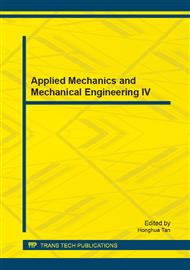[1]
D. Robinson, R. Palaninathan: Thermal analysis of piston casting using 3-D finite element method, Finite Elements in Analysis and Design , 2001, 37: 85-95.
DOI: 10.1016/s0168-874x(00)00020-2
Google Scholar
[2]
Jilin Lei, Lizhong Shen, Yongzhong Yang, Yuhua Bi: Finite Element Analysis and Temperature Field Measurement of 4100QBZ Turbocharged Diesel Engine Piston, Transactions of CSICE, 2007 , 25 (5): 445-450.
Google Scholar
[3]
Ekrem Buyukkaya, Muhammet Cerit: Thermal analysis of a ceramic coating diesel engine piston using 3-D finite element method, Surface and Coatings Technology, 2007, 202(2): 398-402.
DOI: 10.1016/j.surfcoat.2007.06.006
Google Scholar
[4]
C.D. Rakopoulos , G.C. Mavropoulos: Study of the steady and transient temperature field and heat flow in the combustion chamber components of a medium speed diesel engine using finite element analyses, International Journal of Energy Research 1996, 20(5): 437–464.
DOI: 10.1002/(sici)1099-114x(199605)20:5<437::aid-er169>3.3.co;2-a
Google Scholar
[5]
C.D. Rakopoulos G.C. Mavropoulos: Components heat transfer studies in a low heat rejection DI diesel engine using a hybrid thermostructural finite element model, Applied Thermal Engineering, 1998, 18(5): 301–316.
DOI: 10.1016/s1359-4311(97)00055-0
Google Scholar
[6]
Hosokawa, T. Tsukada, H., Maede, Y. Nakakubo, T. Nakada, M.: Development of computer aided engineering for piston design, 1989, SAE Technical Paper 890775.
DOI: 10.4271/890775
Google Scholar
[7]
Andreas P. Panayi , Harold J. Schock : Piston Finite Element Modeling for the Estimation of Hydrodynamic and Contact Forces and Moments, ASME 2006 Internal Combustion Engine Division Fall Technical Conference , November 5–8, 2006 , Sacramento, California, USA.
DOI: 10.1115/icef2006-1587
Google Scholar
[8]
Yong Liu, R.D. Reitz: Modeling of heat conduction within chamber walls for multi-dimensional internal combustion engine simulations. Heat and mass Transfer, 1998, 41(6-7): 859-869.
DOI: 10.1016/s0017-9310(97)00178-6
Google Scholar
[9]
Gary Borman, Kazuie Nishiwaki, Internal-combustion engine heat transfer, Progress in Energy and Combustion Science, 1987, 13(1): 1–46.
DOI: 10.1016/0360-1285(87)90005-0
Google Scholar
[10]
Ping Sun, Ling Zhang, Weicheng Wang: Experimental Measurement and FEA for the Thermal Load of the Piston in Diesel Engine, Small Internal Combustion Engine and Motorcycle, 2008, 37(3): 59-62.
Google Scholar


